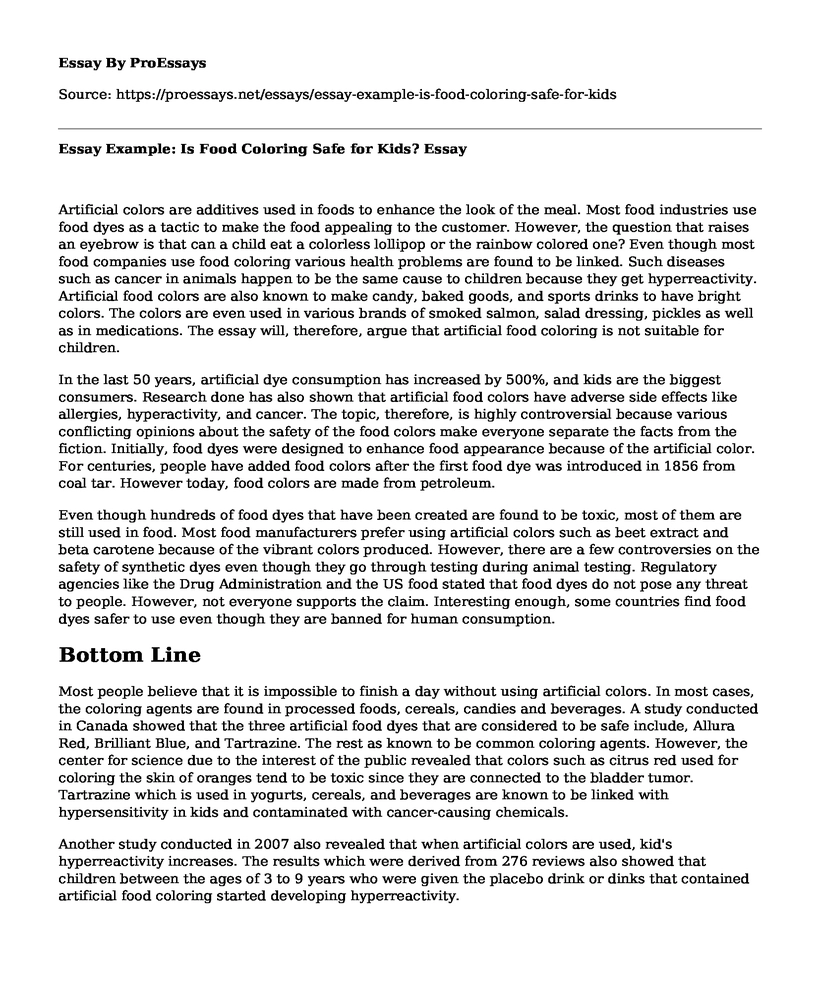Artificial colors are additives used in foods to enhance the look of the meal. Most food industries use food dyes as a tactic to make the food appealing to the customer. However, the question that raises an eyebrow is that can a child eat a colorless lollipop or the rainbow colored one? Even though most food companies use food coloring various health problems are found to be linked. Such diseases such as cancer in animals happen to be the same cause to children because they get hyperreactivity. Artificial food colors are also known to make candy, baked goods, and sports drinks to have bright colors. The colors are even used in various brands of smoked salmon, salad dressing, pickles as well as in medications. The essay will, therefore, argue that artificial food coloring is not suitable for children.
In the last 50 years, artificial dye consumption has increased by 500%, and kids are the biggest consumers. Research done has also shown that artificial food colors have adverse side effects like allergies, hyperactivity, and cancer. The topic, therefore, is highly controversial because various conflicting opinions about the safety of the food colors make everyone separate the facts from the fiction. Initially, food dyes were designed to enhance food appearance because of the artificial color. For centuries, people have added food colors after the first food dye was introduced in 1856 from coal tar. However today, food colors are made from petroleum.
Even though hundreds of food dyes that have been created are found to be toxic, most of them are still used in food. Most food manufacturers prefer using artificial colors such as beet extract and beta carotene because of the vibrant colors produced. However, there are a few controversies on the safety of synthetic dyes even though they go through testing during animal testing. Regulatory agencies like the Drug Administration and the US food stated that food dyes do not pose any threat to people. However, not everyone supports the claim. Interesting enough, some countries find food dyes safer to use even though they are banned for human consumption.
Bottom Line
Most people believe that it is impossible to finish a day without using artificial colors. In most cases, the coloring agents are found in processed foods, cereals, candies and beverages. A study conducted in Canada showed that the three artificial food dyes that are considered to be safe include, Allura Red, Brilliant Blue, and Tartrazine. The rest as known to be common coloring agents. However, the center for science due to the interest of the public revealed that colors such as citrus red used for coloring the skin of oranges tend to be toxic since they are connected to the bladder tumor. Tartrazine which is used in yogurts, cereals, and beverages are known to be linked with hypersensitivity in kids and contaminated with cancer-causing chemicals.
Another study conducted in 2007 also revealed that when artificial colors are used, kid's hyperreactivity increases. The results which were derived from 276 reviews also showed that children between the ages of 3 to 9 years who were given the placebo drink or dinks that contained artificial food coloring started developing hyperreactivity.
Cite this page
Essay Example: Is Food Coloring Safe for Kids?. (2022, Dec 27). Retrieved from https://proessays.net/essays/essay-example-is-food-coloring-safe-for-kids
If you are the original author of this essay and no longer wish to have it published on the ProEssays website, please click below to request its removal:
- Benefits and Potential Problems of Prescription Drugs
- Professional-Plan Health Care Field Career Choices Paper Example
- World Federation of the Deaf Review Paper Example
- Research Paper on Strengths and Weaknesses of Government Nutrient Recommendations
- Essay Example on High-Profile Career, Family Sacrifice: The Story of Anne Marie Slaughter
- Essay Example on Disabilities & Our Communities: Inevitable Issues & Anticipated Futures
- History of the Bacteria - Free Essay Example







